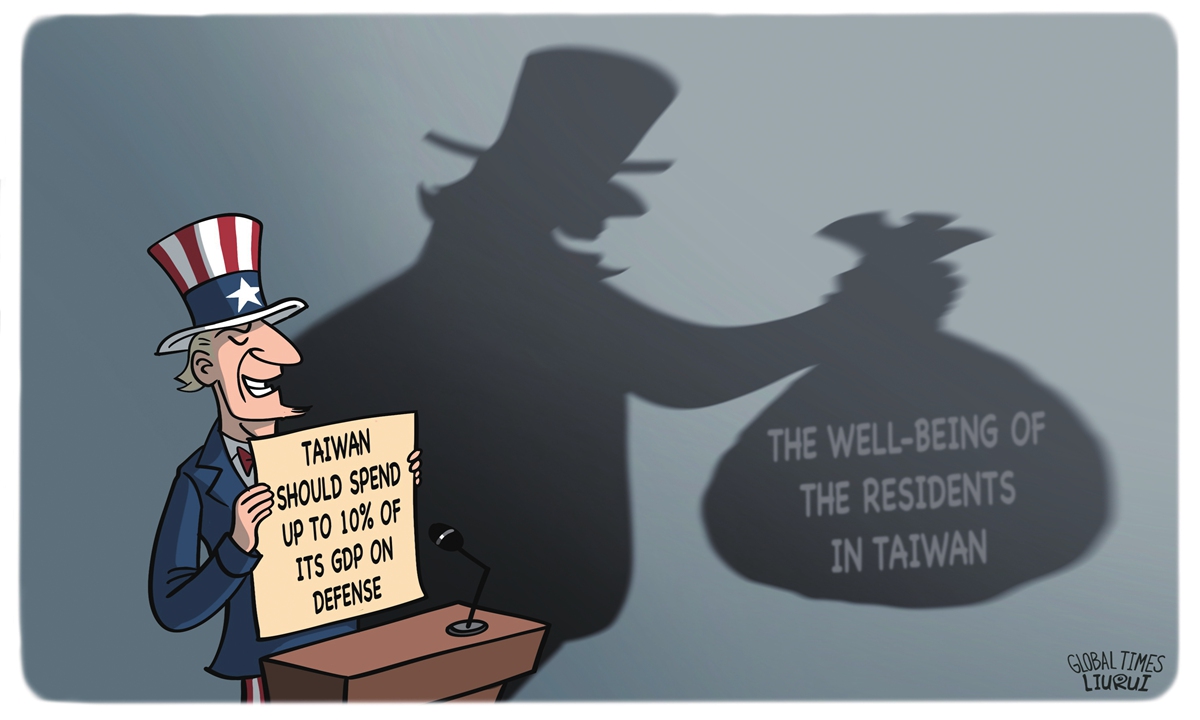
Illustration: Liu Rui/GT
According to Reuters, on Tuesday, John Noh, the nominee for the Pentagon's senior official for the Indo-Pacific region, expressed strong support during his confirmation hearing at the Senate Armed Services Committee for US President Donald Trump's assertion that Taiwan should spend up to 10 percent of its GDP on defense. In response, head of the regional defense authority of Taiwan Koo Li-hsiung said that the Taiwan island's core defense spending will exceed 3 percent of GDP next year, and would gradually increase to 5 percent to fulfill a promise made by Taiwan's regional leader Lai Ching-te.
However, whether it's 3 percent or 5 percent, neither figure appears to satisfy the US appetite. That 10 percent target resembles more of a sky-high "protection fee invoice" than a genuine security objective. Beneath this demand lies a strategic calculation aimed at pushing Taiwan residents toward a precarious situation. Such a lavish military budget would significantly restrict resources for social welfare, education, healthcare, and other critical areas, making the well-being of the island's residents the greatest casualty of the US strategy toward China.
The 10 percent defense spending target proposal has triggered fierce reaction within the island. The Kuomintang legislators said that such a high military budget usually corresponds to wartime levels - and questioned where America's so-called "security promise" is. They argue that funneling over 80 percent of the annual budget into defense and arms procurement leaves other sectors with nothing, amounting to a "wanton use of force."
Zhu Guilan, an assistant professor at Tsinghua University's Institute of Taiwan Studies, told the Global Times that the 10 percent demand is fundamentally illogical and appears more like a bargaining chip for Washington to pressure the region to conform to US strategic interests. The US trick involves exaggerating the mainland's military threat to Taiwan, coercing and pressuring the island to increase its military spending and purchase weapons from the US, ultimately benefiting American arms dealers and tying Taiwan more closely to serve the US interests.
The DPP authorities have been increasing military spending year after year, yet public skepticism continues to grow within the island. Many residents are wondering "where America's commitment is" and questioning whether spending so much money can truly "guarantee Taiwan's security.''
The Lai authorities' reckless arms purchases have sparked strong public dissatisfaction. In August of this year, public opinion within the island angrily asked, "Can't we allocate 1 percent of the 3 percent defense budget for disaster relief?" Zhu told the Global Times that in the context of slowing economic growth and increasing public pressure, the DPP authorities' insistence on increasing military spending undoubtedly imposes a heavy financial burden on Taiwan households. If military spending rises to 5 percent or even 10 percent, it will inevitably further weaken funding for education, healthcare, and social security.
The true will of the residents in Taiwan is to allocate more resources toward improving education and revitalizing the economy, not to be dragged into an endless arms race. The DPP authorities' continual shamelessly fawning over the US and selling Taiwan out will only plunge the island deeper into fiscal difficulties and social division. History has repeatedly shown that exorbitant military spending does not bring security; it only drags Taiwan further into the US' strategic chessboard.
Genuine security will not stem from increased defense spending and arms acquisitions. The US-proposed target of 10 percent of GDP for defense is not only a financial burden that Taiwan cannot bear, but also a serious squeeze on the livelihood of local residents. Only by returning to the 1992 Consensus and promoting cross-Straits exchanges and cooperation can Taiwan break free from the shackles of "protection fees" and achieve genuine peace and prosperity.



